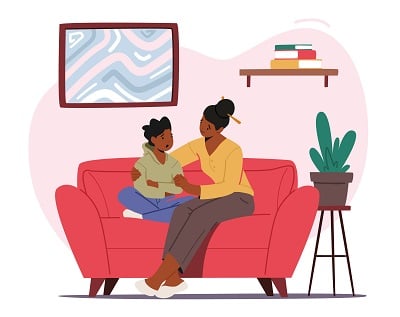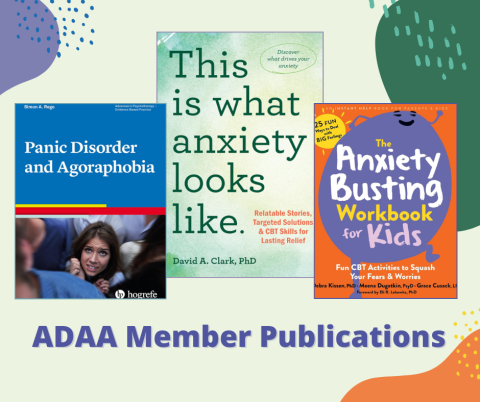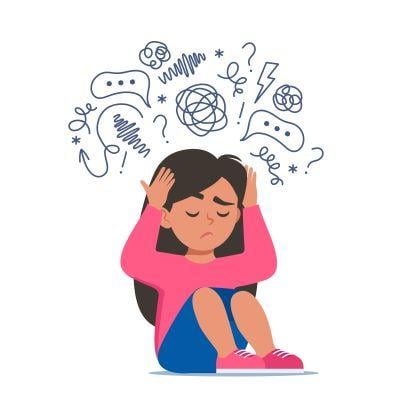Should You Tell Your Child Their Mental Health Diagnosis?
Should You Tell Your Child Their Mental Health Diagnosis?

The other day a colleague shared a story with me about one of her young patients who had been having terrifying intrusive thoughts of hurting other people. Understand that this was the sweetest, gentlest kid you could ever imagine. Afraid that she was going to act on those frightening thoughts, she told her parents. Her parents were terrified—what’s wrong with my child? What do we do? By the time the parents got in to see my colleague, they had figured out through google searching that the issue was probably obsessive compulsive disorder (OCD)—but they didn’t want to tell their daughter because they were afraid it would upset her and make her feel “labeled” and scared that something was really wrong with her. Fortunately, my colleague advised the parents to tell their daughter what was going on, explaining that not knowing what was happening in her own mind and personalizing it was so much worse. When the daughter found out there was a name for what was going on with her, that it wasn’t her fault, and that there was a highly effective treatment for it—she was immediately relieved. She had felt hopeless like she was just a terrible person and there was nothing she could do about it. Instead of feeling diminished by the diagnosis as her caring parents had most feared, the daughter felt like she was given her life back. She started treatment and is well on her way to freeing herself from OCD.
No parent wants to make things worse for their child, and certainly not when they’re already struggling with mental health symptoms, but explaining what is causing a child’s inner havoc and distress or outer symptoms can be a relief. It can separate the child from the symptoms.
It can offer hope and a new narrative—they aren’t a bad kid, or weird; there is a reason for their struggles. It’s not their fault, it’s not who they are, it’s what is happening to them now. Additionally, given the highly effective treatments we have for many mental health disorders—knowing that your child’s symptoms are not mysterious, but rather are known and have been studied, means there are likely solutions.
Names Make All the Difference
There’s a line in a Talking Heads song—from my college days— that plays in my head often while working with kids: “There’s a name for it; Names make all the difference in the world.” Names do make all the difference. Whether it’s the disturbing intrusive thoughts of OCD, the frightening sensations and catastrophic worries of anxiety, the spirals of negative thoughts of depression, the jarring flashbacks of PTSD, or the wandering focus of ADHD, having a name for uncomfortable and unpleasant emotional experiences can help children feel a sense of control and perspective. They don’t have to search themselves to know—why is this happening to me? What is wrong with me? Questions that often lead to a feeling of shame or a sense of fear that something is so wrong that it is beyond hope—that they are different or unacceptable or that their symptoms are life threatening—leave kids feeling like they need to hide their symptoms rather than learn how to take charge of them.
When children and teens are given a name for what’s going on for them emotionally, it can feel less personal. It’s like giving them an aerial view of the situation instead of feeling stuck. They can begin to reclaim the microphone in their mind away from their symptoms: It’s not the worry or anger or OCD who is in charge, they are. They can externalize thoughts in an Inside Out way and say “That’s my OCD,” or “That’s my busy brain,” or “Those are my big feelings.” Kids can learn that they are the executive in charge and decide what to do with these messages.
It Doesn’t Have to Be the Formal Name! Be Creative and Descriptive
When I work with a family, I ask parents what their comfort level is with using clinical terms. It really doesn’t matter what word is used to describe what’s going on, as long as it is empowering to the child. A diagnosis doesn’t have to be the formal name—OCD, or depression, or panic disorder each of those can be made into more friendly descriptive terms: OCD becomes “sticky thoughts,” depression becomes “sad attacks” or “negative spirals,” panic becomes “the pressing of your inner yikes button,” or “that adrenaline surge thing,” The clinical name isn’t important, in fact even if kids just refer to their symptoms as “that thing” that’s happening, there is a shared understanding that “that thing” is not their fault, is something that millions of others experience, and it can change. With a name that the child feels comfortable with, you then have a way of referring to the symptoms when they are happening: “It looks like Checker Guy is really bothering you right now, making you feel like you have to keep checking that the light is off. What do you want to say? Can I help?” Contrast this with a well-meaning parent asking—“Why are you flicking the light off and on?”
Importantly, even if a child has been given a diagnosis, there’s still room for essential “editing” to preserve their sense of self and agency. It’s not that they “are OCD,” they “have OCD.” It’s not that they are depressed, it’s that they have depression, or even they are having a lot of depressed thoughts right now.
A Sample Script for Talking to Kids About Mental Health Challenges
The way we introduce a name or diagnosis sets the tone for how a child feels about themselves: are they the problem, or do they have a problem. Here are some ideas to get the conversation moving in the right direction.
You have a wonderful brain, some thoughts and ideas that you don’t want to have, and aren’t true, are getting stuck and making it hard for you to think and making you feel bad. It’s not your fault, you did nothing wrong for this to happen. Millions of people in the world are having the same kind of experiences right now. The really good news is that there are lots of things you can do to retrain your brain out of those patterns. But first, it’s going to help to have a name for this—what would you like to call it? That way, when you notice those thoughts and feelings you can remind yourself—that “thing” is happening again—what do I want to do next? Just noticing and naming helps you stop after a few thoughts instead of being barraged with so many it is overwhelming—it gives you choices. You can say, “That’s my negative thinking, or that’s Disaster Man." You can ask, "Are these thoughts important, are they true, or are they just stuck?” There are solutions that really work to respond differently to these symptoms. You will get better!
We live in a time when mental health challenges are pervasive for our young people. And that is a heavy thought. At the same time, we’ve never had more effective treatments. Your child is not their diagnosis. Those are patterns the brain gets organized into and we can—by having the power of knowing what those patterns are—help our children navigate to a better place. Out of compassion we may be afraid that a diagnosis reduces our child to a problem—but in the best of situations, handing children a name for what is going on for them provides a roadmap, it opens the door and points to the path of freedom. Rather than limiting them, having a name for your child’s mental health symptoms can help them to pinpoint and compartmentalize the problem, rather than feeling like their symptoms define them. That leaves all the room for your child to follow their path of growth unencumbered. Here’s to less worry, earlier intervention, and greater understanding all around.
This article was originally published on PsychologyToday.com




















